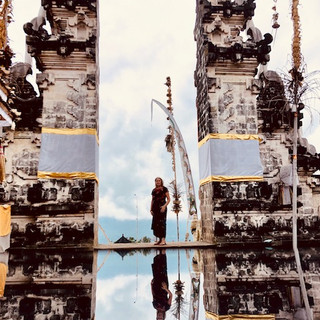Stairway to Heaven
- Carol Anne Jones

- Feb 14, 2019
- 3 min read
Updated: Aug 24, 2020
February sees me in Bali and I can tell you since arriving I’ve climbed a lot of stairs due to visiting about three temples. So much ascent and descent reminds me of the Led Zeppelin song, Stairway to Heaven written by Robert Plant and Jimmy Page which has a meaning of its own of course. My own Gap in Time series visualised a stairway in the piece Into the ethereal featuring the stairway from Wat Arun in Bangkok. That piece had its own meaning describing the perception of an aviator ascending from the ground to flight. When the word "ethereal," debuted in English in the 1500s, it referred specifically to regions beyond the Earth, but it gradually came to refer to anything heavenly or airy.
The symbol a staircase is connected with the idea of ascent and ascension as well as descent and
although ladders, stairs, ropes and wings all appear to be similar as a means of ascent, there is a very distinct difference symbolically. The ones with wings are those who are capable of having spiritual experiences with little difficulty. Those with ladders and stairs have a rather slow upward climb that involves stages and steps towards the goal of spiritual enlightenment.
Yesterday I took a trip to Pura Penataran Agung Lempuyang one of 20,000 temples on Bali. It’s located on the slope of Mount Lempuyang, a holy mountain, in Karangasem. The temple is otherwise known as the Gateway of Heaven and regarded as one of the most important temples on Bali. The temple sits at top of the mountain with views of the volcano Gunung Agung, the highest point on Bali and is framed by the Pura’s temple gate called a Candi Bentar. This is a split gateway, a classical Javanese and Balinese structure commonly found at the entrance of religious compounds, palaces and cemeteries. It is basically a structure split perfectly in two to create a passage in the centre for people to walk through and is usually elevated with a flight of stairs to reach it. The local Balinese make their way up the stairs to ask for divine assistance with problems or request blessings from above.
One thing all Balinese temples have in common is that they’re all open to the sky. The reasoning is that it enables the gods to be summoned during special ceremonies so they can descend from the heavens into the temple before eventually returning home. Mountains are seen as the dwelling places of the gods and the shape of mountains are mirrored in the temple architectural structures. Steps represent spiritual ascent, a link between heaven and earth, stairs symbolise the way to heaven (the ascent) to offer a spiritual, transforming experience.
Bali is a Hindu island with up to 95% of the population actively practising the faith unlike the rest of Indonesia which is almost entirely Muslim. While Hinduism originated from India, the Balinese have put their own unique stamp on the religion with Balinese Hinduism distinctly differing from Indian Hinduism in terms of the worship incorporating local animism, ancestor worship or Pitru Paksha along with reverence for Buddhist saints or Bodhisattava. The beliefs in karma and reincarnation are Hindu, while indigenous practices are evident in the worship of nature and the ancestors, a strong belief in magic and in the power of the spirit world. Thus, the Balinese seem to devote most of their waking hours to an endless series of physically and financially exhausting offerings, exorcisms, purifications, processions, and temple ceremonies.
The interaction between Balinese superstitions and tourism is an interesting one. Of course, the economy of Bali has improved greatly due to the impact of tourism, however Balinese superstitions have a curious way of blending with outside viewpoints. Balinese craftspeople believe hotels are living things with a complex cosmological order. For example, when a pillar made from a tree trunk is erected, the end where the roots were must always face downward because trees are the homes of spirits. Sometimes construction has to wait weeks for a propitious day to begin, say for example the process of thatching roofs, because the wild grass is sacred, it must be tied to the rafters with bamboo string as thick as an angel's eyebrow. Describing the problem-plagued construction of a new hotel, a manager said;
"the generator repeatedly failed, and a worker spotted a ghost on the area. We solved it by hiring a Penanda, who sealed off the property with energy lines and sent away negative spirits from the magically charged spots. Because at the spot defined as negatively charged, a bulldozer kept stalling there, to placate the spirits there, a temple was built and consecrated with chicken blood”.
It's a curious island Bali and well worth a visit.
Text Sources: Wikipedia, BBC, CNN, and various books, websites and other publications.





















Comments